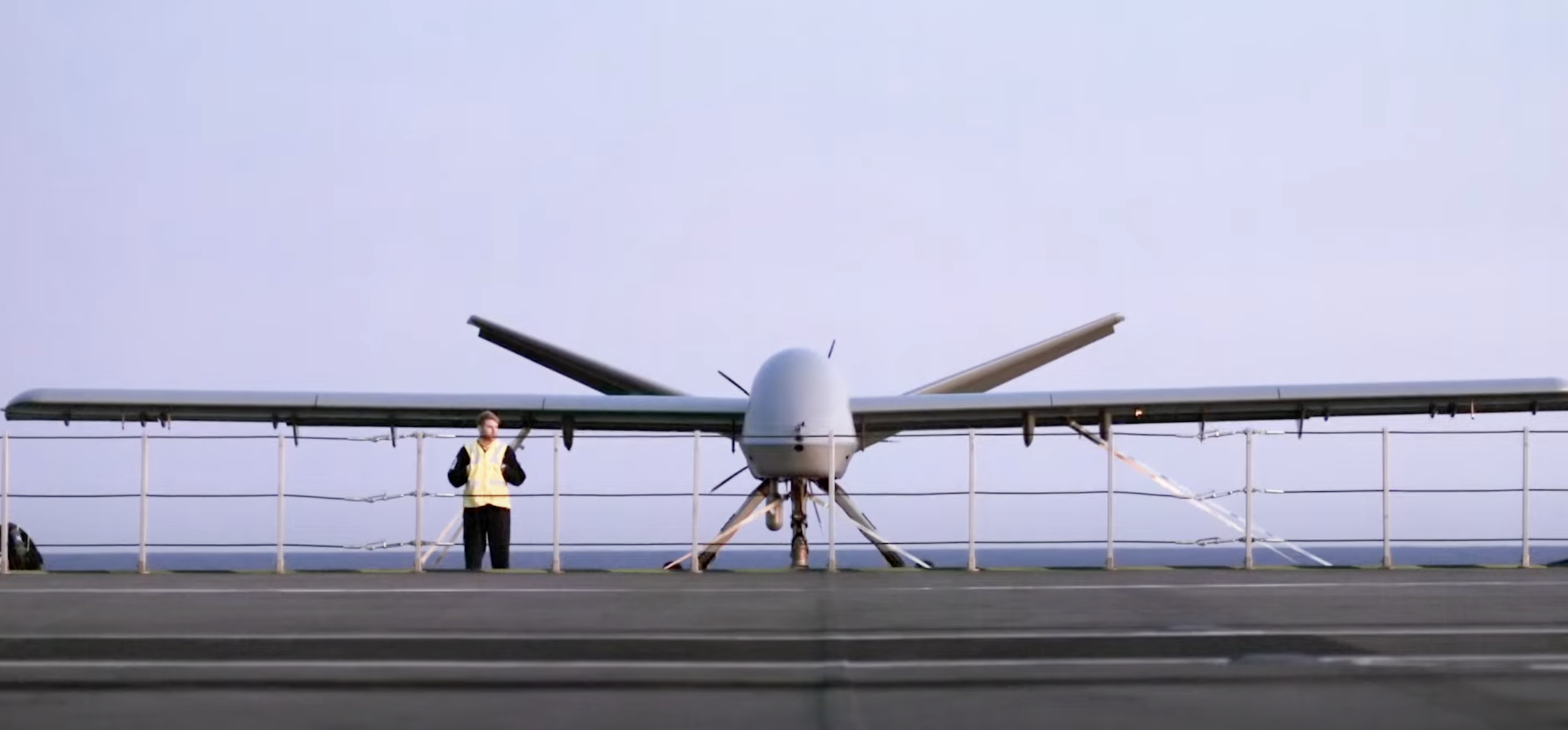General Atomics has released a new video of testing of its Mojave drone aboard the U.K. Royal Navy’s aircraft carrier HMS Prince of Wales back in November. The montage of clips, seen below, offers previously unseen views of the drone in flight and making short takeoffs and landings from the ship, which does not have aircraft-launching catapults or arresting wires – at least for now.
In cooperation with the Royal Navy, General Atomics tested Mojave on board Prince of Wales on November 15 as the ship sailed off the coast of Virginia. You can read more about this, which marked the first time Mojave operated from an aircraft carrier as well as with the Royal Navy, in The War Zone‘s initial reporting here.

Mojave is derived from the MQ-1C Gray Eagle, a remotely piloted vehicle that traces its roots to the Q-1 Predator. It’s also the cousin of the larger, turboprop-powered MQ-9 Reaper. General Atomics was first revealed in late 2021 and is STOL and rough field capable; making it ideal for various distributed and expeditionary operations, including those from aircraft carriers as well as from remote and austere locales ashore. You can read more about it and its capabilities here and here.
In the footage, we see Mojave being raised from the Prince of Wales’ hangar to its flight deck via an elevator. From there, it is maneuvered into position towards the rear of the vessel’s flight deck prior to takeoff.


Propelling down the flight deck, the drone smoothly lifts into the air at around the 600 foot mark — for context, the Prince of Wales’ flight deck runs some 901-foot-long. In its lightest configuration with a more limited payload package focused on intelligence, surveillance, and reconnaissance (ISR) missions, the drone is able to get airborne in as little as 300 to 400 feet. Additional weight added from extra fuel, sensors, or missiles increases said distance.


While the entirety of Mojave’s takeoff isn’t depicted in the footage, the drone does not use the ship’s ski jump ramp. In total, General Atomics suggests Mojave is capable of flying for 25 hours or more; however, this would require more fuel, adding weight to the drone.

As we’ve noted previously, Mojave could have an endurance of between 10 and 12 hours when launched off a carrier-sized landing area with no weapons, “allowing it to perform everything from persistent armed overwatch for force protection missions in ‘brown water’ environments to airborne communications relay and surveillance functions in ‘blue water’ environments.”
After circling the carrier, it then begins a slow approach for landing. From the video, it appears as if it lands full-stop at around the 400 foot mark on the flight deck; with plenty of deck length left.



Being a part of Mojave’s first carrier takeoff and landing was clearly thrilling for all involved; if a little nerve-wracking.
“It’s sort of like when you take your 4×4 sport utility vehicle out onto a backcountry trail for the first time,” a General Atomics engineer is quoted as saying in a press release that the company put out yesterday along with the new video. “You know it was built for that. You know it’s got a mode for that, it’s got the right tires, high clearance, everything. You just need to go out and prove it.”

In the lead-up to experimental operations with the Royal Navy, General Atomics engineers sought ways to mimic controlling Mojave at sea — given that pilots, up to this point, have always remotely maneuvered the drone from stable ground control stations. As such, they built a ground control station on the back of a truck bed which drove at speeds equivalent to the Prince of Wales while underway at sea to practice operating Mojave from. In total, over 100 takeoffs and landings were practiced using the truck-based control center.
“One thing we learned real quick was that our guys needed seat belts!,” one of General Atomics’ engineers said of the pre-carrier based testing. “We got them set up with harnesses, they continued training and it didn’t take very long to get the hang of it. These are the kinds of things you always learn when you’re taking something from the concept stage to the operational stage.”
The Royal Navy hasn’t indicated whether it intends to procure Mojave specifically for use on its aircraft carriers or not. General Atomics does offer other carrier-deployable drone options. The company has devised a wing-kit which turns its popular MQ-9B Reapers into big deck ship-deployable drones, for example.

However, the Royal Navy is looking towards the possibility of being able to operate a wide variety of platforms — including various fixed-wing uncrewed aircraft — from the Queen Elizabeth class vessels via fitting assisted launch systems and recovery gear to them.
Broadly, there has been a growing interest in operating fixed-wing drones with substantial payload and endurance from amphibious assault ships, helicopter carriers, short-takeoff and vertical landing carriers with large decks, as well as traditional aircraft carriers. This would greatly expand the capabilities of these ships, especially in terms of airborne persistent surveillance, networking and force protection roles.
Whether or not it commits to Mojave specifically, the new footage of it taking off from and landing on the Prince of Wales is a harbinger of the Royal Navy’s uncrewed future operations.
“Integrating the Navy Develop and General Atomics personnel into the Prince of Wales team was key to enabling such a large remotely piloted air system to operate from the deck during this trial, Royal Navy Cmdr. Martin Russell, head of air operations aboard the HMS Prince of Wales, said, “with the capability feeling like a glimpse into the future of these ships.”
Contact the authors: joe@thedrive.com, oliver@thewarzone.com
